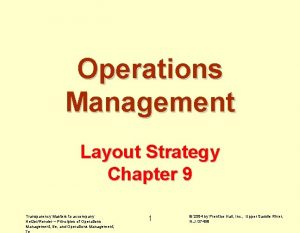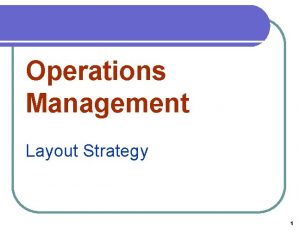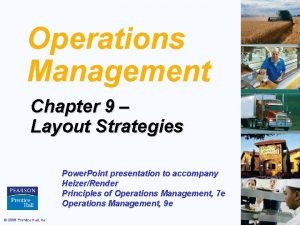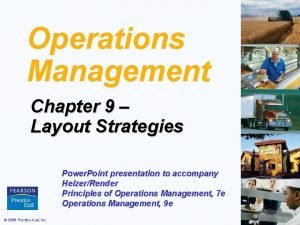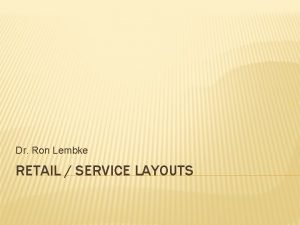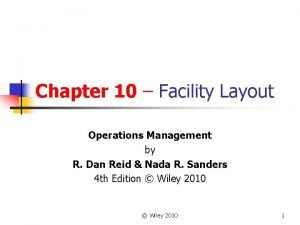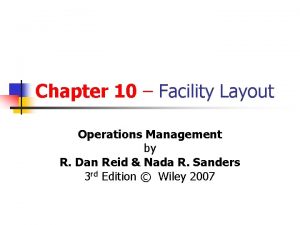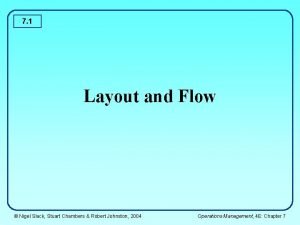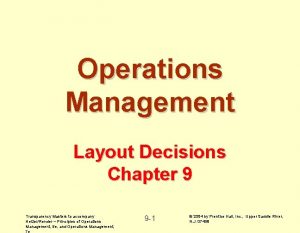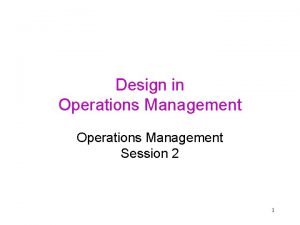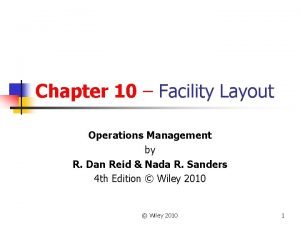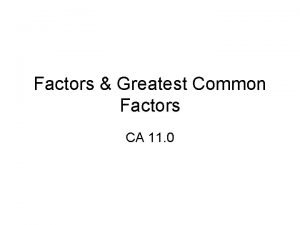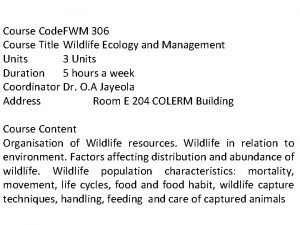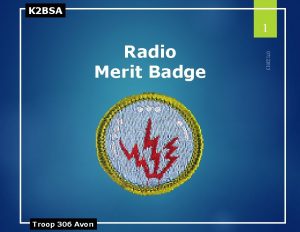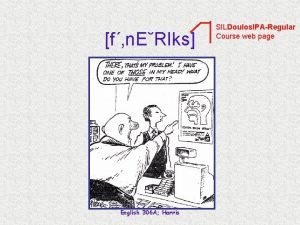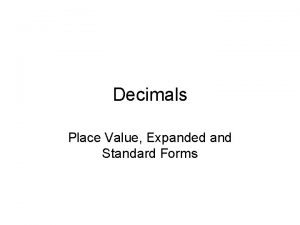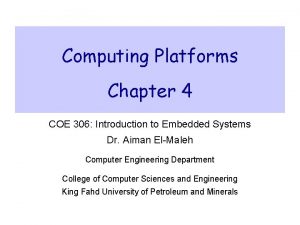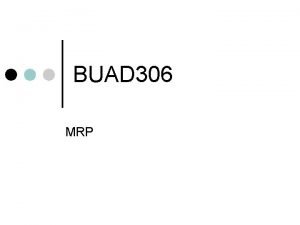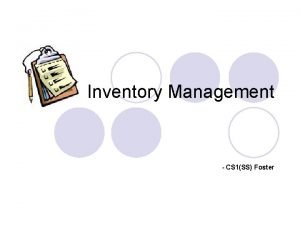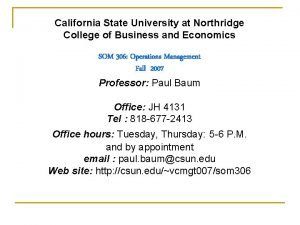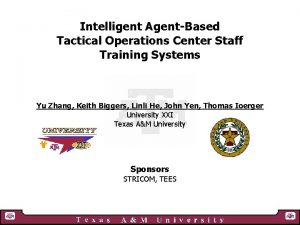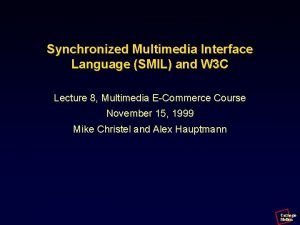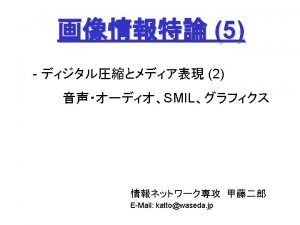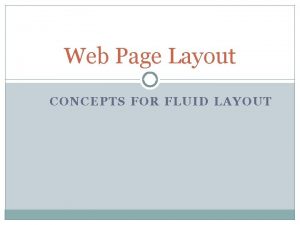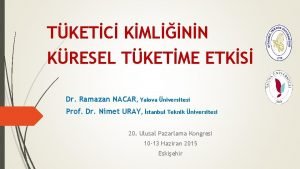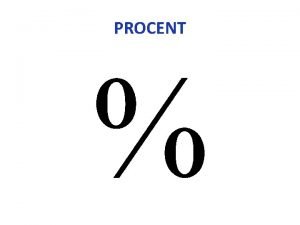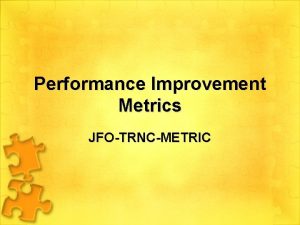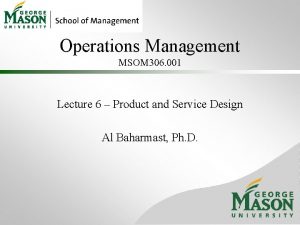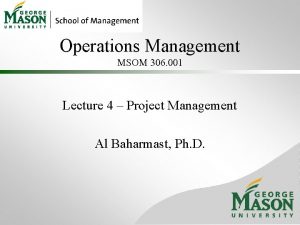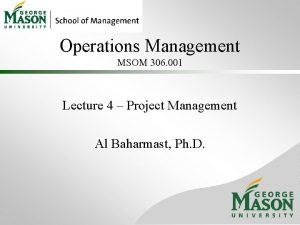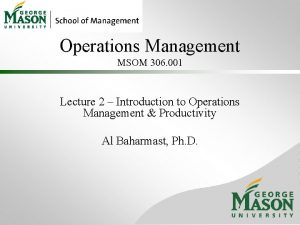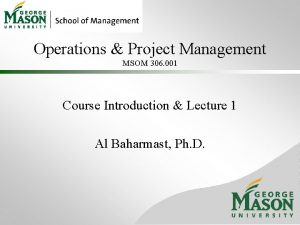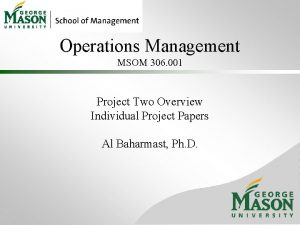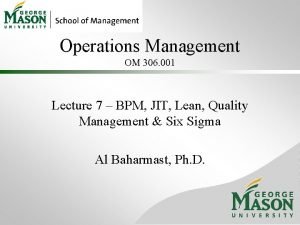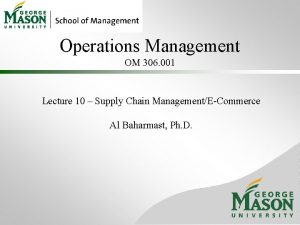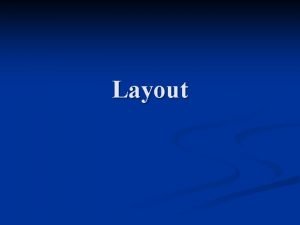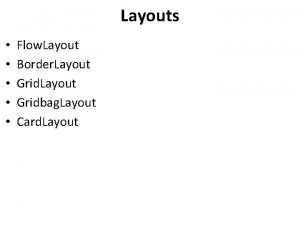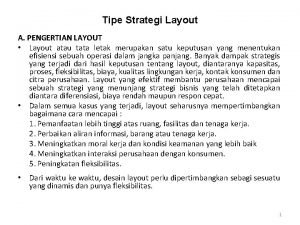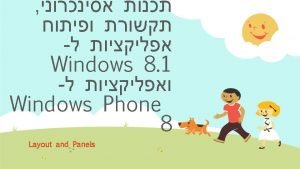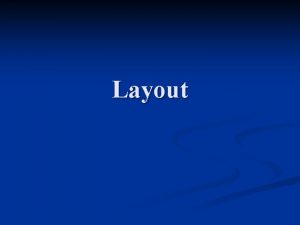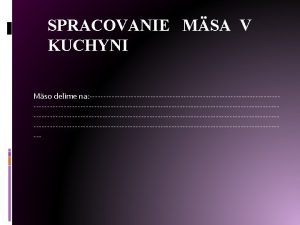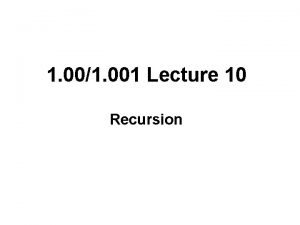Operations Management MSOM 306 001 Lecture 9 Layout















































- Slides: 47

Operations Management MSOM 306. 001 Lecture 9 – Layout Strategies Al Baharmast, Ph. D.

Innovations at Mc. Donald’s þ Indoor seating (1950 s) þ Drive-through window (1970 s) þ Adding breakfast to the menu (1980 s) þ Adding play areas (1990 s) Three out of the four are layout decisions! Some lecture content courtesy of Prentice Hall, Rights Reserved

Mc. Donald’s New Kitchen Layout Fifth major innovation þ Sandwiches assembled in order þ Elimination of some steps, shortening of others þ No food prepared ahead except patty þ New bun toasting machine and new bun formulation þ Repositioning condiment containers þ Savings of $100, 000 per year in food costs Some lecture content courtesy of Prentice Hall, Rights Reserved

Strategic Importance of Layout Decisions The objective of layout strategy is to develop an economic layout that will meet the firm’s competitive requirements Some lecture content courtesy of Prentice Hall, Rights Reserved

Layout Design Considerations þ Higher utilization of space, equipment, and people þ Improved flow of information, materials, or people þ Improved employee morale and safer working conditions þ Improved customer/client interaction þ Flexibility Some lecture content courtesy of Prentice Hall, Rights Reserved

Types of Layout 1. Office layout 2. Retail layout 3. Warehouse layout 4. Fixed-position layout 5. Process-oriented layout 6. Work cell layout 7. Product-oriented layout Some lecture content courtesy of Prentice Hall, Rights Reserved

Types of Layout 1. Office layout - positions workers, their equipment, and spaces/offices to provide for movement of information 2. Retail layout - allocates shelf space and responds to customer behavior 3. Warehouse layout - addresses tradeoffs between space and material handling Some lecture content courtesy of Prentice Hall, Rights Reserved

Types of Layout 4. Fixed-position layout - addresses the layout requirements of large, bulky projects such as ships and buildings 5. Process-oriented layout - deals with low-volume, high-variety production (also called job shop or intermittent production) Some lecture content courtesy of Prentice Hall, Rights Reserved

Types of Layout 6. Work cell layout - a special arrangement of machinery and equipment to focus on production of a single product or group of related products 7. Product-oriented layout - seeks the best personnel and machine utilizations in repetitive or continuous production Some lecture content courtesy of Prentice Hall, Rights Reserved

Office Layout þ Grouping of workers, their equipment, and spaces to provide comfort, safety, and movement of information þ Movement of information is main distinction þ Typically in state of flux due to frequent technological changes Some lecture content courtesy of Prentice Hall, Rights Reserved

Supermarket Retail Layout þ Objective is to maximize profitability per square foot of floor space þ Sales and profitability vary directly with customer exposure Some lecture content courtesy of Prentice Hall, Rights Reserved

Five Helpful Ideas for Supermarket Layout 1. Locate high-draw items around the periphery of the store 2. Use prominent locations for high-impulse and high-margin items 3. Distribute power items to both sides of an aisle and disperse them to increase viewing of other items 4. Use end-aisle locations 5. Convey mission of store through careful positioning of lead-off department Some lecture content courtesy of Prentice Hall, Rights Reserved

Servicescapes þ Ambient conditions - background characteristics such as lighting, sound, smell, and temperature þ Spatial layout and functionality - which involve customer circulation path planning, aisle characteristics, and product grouping þ Signs, symbols, and artifacts characteristics of building design that carry social significance Some lecture content courtesy of Prentice Hall, Rights Reserved

Retail Slotting þ Manufacturers pay fees to retailers to get the retailers to display (slot) their product þ Contributing factors þ Limited shelf space þ An increasing number of new products þ Better information about sales through POS data collection þ Closer control of inventory Some lecture content courtesy of Prentice Hall, Rights Reserved

Warehousing and Storage Layouts þ Objective is to optimize trade-offs between handling costs and costs associated with warehouse space þ Maximize the total “cube” of the warehouse – utilize its full volume while maintaining low material handling costs Some lecture content courtesy of Prentice Hall, Rights Reserved

Warehousing and Storage Layouts Material Handling Costs þ All costs associated with the transaction þ Incoming transport þ Storage þ Finding and moving material þ Outgoing transport þ Equipment, people, material, supervision, insurance, depreciation þ Minimize damage and spoilage Some lecture content courtesy of Prentice Hall, Rights Reserved

Cross-Docking þ Materials are moved directly from receiving to shipping and are not placed in storage in the warehouse þ Requires tight scheduling and accurate shipments, typically with bar code identification Some lecture content courtesy of Prentice Hall, Rights Reserved

Random Stocking þ Typically requires automatic identification systems (AISs) and effective information systems þ Random assignment of stocking locations allows more efficient use of space 1. Maintain list of open locations 2. Maintain accurate records 3. Sequence items to minimize travel time 4. Combine picking orders 5. Assign classes of items to particular areas Some lecture content courtesy of Prentice Hall, Rights Reserved

Customization þ Value-added activities performed at the warehouse þ Enable low cost and rapid response strategies þ Assembly of components þ Loading software þ Repairs þ Customized labeling and packaging Some lecture content courtesy of Prentice Hall, Rights Reserved

Fixed-Position Layout þ Product remains in one place þ Workers and equipment come to site þ Complicating factors þ Limited space at site þ Different materials required at different stages of the project þ Volume of materials needed is dynamic Some lecture content courtesy of Prentice Hall, Rights Reserved

Alternative Strategy As much of the project as possible is completed off-site in a productoriented facility This can significantly improve efficiency but is only possible when multiple similar units need to be created Some lecture content courtesy of Prentice Hall, Rights Reserved

Process-Oriented Layout þ Like machines and equipment are grouped together þ Flexible and capable of handling a wide variety of products or services þ Scheduling can be difficult and setup, material handling, and labor costs can be high Some lecture content courtesy of Prentice Hall, Rights Reserved

Process-Oriented Layout ER triage room Patient A - broken leg Emergency room admissions Patient B - erratic heart pacemaker Surgery Laboratories Radiology ER Beds Pharmacy Billing/exit Figure 9. 3 Some lecture content courtesy of Prentice Hall, Rights Reserved

Process-Oriented Layout þ Arrange work centers so as to minimize the costs of material handling þ Basic cost elements are þ Number of loads (or people) moving between centers þ Distance loads (or people) move between centers Some lecture content courtesy of Prentice Hall, Rights Reserved

Process-Oriented Layout n n Minimize cost = ∑ ∑ Xij Cij i=1 j=1 where n = total number of work centers or departments i, j = individual departments Xij = number of loads moved from department i to department j Cij = cost to move a load between department i and department j Some lecture content courtesy of Prentice Hall, Rights Reserved

Computer Software þ Graphical approach only works for small problems þ Computer programs are available to solve bigger problems þ CRAFT þ ALDEP þ CORELAP þ Factory Flow Some lecture content courtesy of Prentice Hall, Rights Reserved

Work Cells þ Reorganizes people and machines into groups to focus on single products or product groups þ Group technology identifies products that have similar characteristics for particular cells þ Volume must justify cells þ Cells can be reconfigured as designs or volume changes Some lecture content courtesy of Prentice Hall, Rights Reserved

Advantages of Work Cells • • Reduced work-in-process inventory Less floor space required Reduced raw material and finished goods inventory Reduced direct labor Heightened sense of employee participation Increased use of equipment and machinery Reduced investment in machinery and equipment Some lecture content courtesy of Prentice Hall, Rights Reserved

Improving Layouts Using Work Cells Current layout - workers in small closed areas. Cannot increase output without a third worker and third set of equipment. Improved layout - cross-trained workers can assist each other. May be able to add a third worker as additional output is needed. Figure 9. 10 (a) Some lecture content courtesy of Prentice Hall, Rights Reserved

Improving Layouts Using Work Cells Current layout - straight lines make it hard to balance tasks because work may not be divided evenly Figure 9. 10 (b) Improved layout - in U shape, workers have better access. Four cross-trained workers were reduced. U-shaped line may reduce employee movement and space requirements while enhancing communication, reducing the number of workers, and facilitating inspection Some lecture content courtesy of Prentice Hall, Rights Reserved

Requirements of Work Cells 1. Identification of families of products 2. A high level of training and flexibility on the part of employees 3. Either staff support or flexible, imaginative employees to establish work cells initially 4. Test (poka-yoke) at each station in the cell Some lecture content courtesy of Prentice Hall, Rights Reserved

Staffing and Balancing Work Cells Determine the takt time total work time available Takt time = units required Determine the number of operators required total operation time required Workers required = takt time Some lecture content courtesy of Prentice Hall, Rights Reserved

Staffing Work Cells Example 600 Mirrors per day required Mirror production scheduled for 8 hours per day From a work balance chart total operation time = 140 seconds Standard time required 60 50 40 30 20 10 0 Assemble Paint Test Label Pack for shipment Operations Some lecture content courtesy of Prentice Hall, Rights Reserved

Staffing Work Cells Example 600 Mirrors per day required Mirror production scheduled for 8 hours per day From a work balance chart total operation time = 140 seconds Takt time = (8 hrs x 60 mins) / 600 units =. 8 mins = 48 seconds total operation time required Workers required = takt time = 140 / 48 = 2. 91 Some lecture content courtesy of Prentice Hall, Rights Reserved

Work Balance Charts þ Used for evaluating operation times in work cells þ Can help identify bottleneck operations þ Flexible, cross-trained employees can help address labor bottlenecks þ Machine bottlenecks may require other approaches Some lecture content courtesy of Prentice Hall, Rights Reserved

Focused Work Center and Focused Factory þ Focused Work Center þ Identify a large family of similar products that have a large and stable demand þ Moves production from a general-purpose, process-oriented facility to a large work cell þ Focused Factory þ A focused work cell in a separate facility þ May be focused by product line, layout, quality, new product introduction, flexibility, or other requirements Some lecture content courtesy of Prentice Hall, Rights Reserved

Focused Work Center and Focused Factory Work Cell Focused Work Center Focused Factory A work cell is a temporary product-oriented arrangement of machines and personnel in what is ordinarily a processoriented facility. A focused work center is a A focused factory is a permanent productpermanent facility to oriented arrangement of produce a product or machines and personnel in component in a productwhat is ordinarily a process oriented facility. Many -oriented facility. focused factories currently being built were originally part of a process-oriented facility. Example: A job shop with machinery and personnel; rearranged to produce 300 unique control panels. Example: Pipe bracket manufacturing at a shipyard. Example: A plant to produce window mechanism for automobiles. Table 9. 2 Some lecture content courtesy of Prentice Hall, Rights Reserved

Repetitive and Product-Oriented Layout Organized around products or families of similar high-volume, low-variety products þ Volume is adequate for high equipment utilization þ Product demand is stable enough to justify high investment in specialized equipment þ Product is standardized or approaching a phase of life cycle that justifies investment þ Supplies of raw materials and components are adequate and of uniform quality Some lecture content courtesy of Prentice Hall, Rights Reserved

Product-Oriented Layouts þ Fabrication line þ Builds components on a series of machines þ Machine-paced þ Require mechanical or engineering changes to balance þ Assembly line þ Puts fabricated parts together at a series of workstations þ Paced by work tasks þ Balanced by moving tasks Both types of lines must be balanced so that the time to perform the work at each station is the same Some lecture content courtesy of Prentice Hall, Rights Reserved

Product-Oriented Layouts Advantages 1. 2. 3. 4. 5. Low variable cost per unit Low material handling costs Reduced work-in-process inventories Easier training and supervision Rapid throughput Disadvantages 1. High volume is required 2. Work stoppage at any point ties up the whole operation 3. Lack of flexibility in product or production rates Some lecture content courtesy of Prentice Hall, Rights Reserved

Assembly-Line Balancing þ Objective is to minimize the imbalance between machines or personnel while meeting required output þ Starts with the precedence relationships 1. Determine cycle time 2. Calculate theoretical minimum number of workstations 3. Balance the line by assigning specific tasks to workstations Some lecture content courtesy of Prentice Hall, Rights Reserved

Copier Example Performance Task Must Follow Time Task Listed Task (minutes) Below A 10 — B 11 A C 5 B D 4 B E 12 A F 3 C, D G 7 F H 11 E I 3 G, H Total time 66 This means that tasks B and E cannot be done until task A has been completed Some lecture content courtesy of Prentice Hall, Rights Reserved

Copier Example Performance Task Must Follow Time Task Listed Task (minutes) Below A 10 — B 11 A C 5 B 10 D 4 B A E 12 A F 3 C, D G 7 F H 11 E I 3 G, H Total time 66 5 11 B Some lecture content courtesy of Prentice Hall, Rights Reserved 12 E C 4 D 3 7 F G 3 11 I H Figure 9. 13

Copier Example 480 available Performance Task Must Follow mins per day Time Task Listed 40 units required Task (minutes) Below A 10 — B 11 A Production time C 5 B available per day Cycle D 4 B time = Units required per day E 12 A = 480 / 40 5 F 3 C, D = 12 minutes per unit C G 7 F 10 11 3 7 n H 11 E for task. Fi A ∑ Time B G Minimum I 3 G, H 4 i=1 3 number of = Cycle Dtime Total time 66 workstations I 12 11 = 66 / 12 E H = 5. 5 or 6 stations Figure 9. 13 Some lecture content courtesy of Prentice Hall, Rights Reserved

Line-Balancing Heuristics Copier Example 1. Longest task time Choose the available 480 task with the available Performance Task Must Follow longest task time mins per day Time Task Listed unitsthe required Task 2. Most (minutes) following tasks Below Choose the available 40 task with following tasks A 10 —largest number of Cycle time = 12 mins B 11 A Minimum 3. Ranked positional weight Choose the available task for = 5. 5 or 6 C 5 B workstations which the sum of following task D 4 Btimes is the longest E 12 A F 4. Shortest 3 task time C, Choose D the available 5 task with the C G 7 Fshortest 10 task time 11 3 7 H 11 E 5. Least number of Choose. Athe available task with B F the G I 3 G, H 4 following tasks least number of following tasks 3 Total time 66 D I 12 11 E H Table 9. 4 Figure 9. 13 Some lecture content courtesy of Prentice Hall, Rights Reserved

Copier Example 480 available Performance Task Must Follow mins per day Time Task Listed 40 units required Task (minutes) Below A 10 — Cycle time = 12 mins B 11 A Minimum Station 5 = 5. 5 or 6 C 52 B workstations C B D 4 11 3 7 E 10 12 A B G F A 3 C, D F 4 3 G 7 F D E Station 4 H 11 I I 3 G, H 12 11 Station 6 Stationtime 66 Total E H 1 Station 3 Station 5 Some lecture content courtesy of Prentice Hall, Rights Reserved Figure 9. 14

Copier Example 480 available Performance Task Must Follow mins per day Time Task Listed 40 units required Task (minutes) Below A 10 — Cycle time = 12 mins B 11 A Minimum = 5. 5 or 6 C 5 B workstations D 4 B E 12 A F 3 C, D ∑ Task times G 7 F Efficiency = (actual number of. E workstations) x (largest cycle time) H 11 I 3 G, H = 66 minutes / (6 stations) x (12 minutes) Total time 66 = 91. 7% Some lecture content courtesy of Prentice Hall, Rights Reserved
 Operations management lecture notes doc
Operations management lecture notes doc Product-oriented layout example
Product-oriented layout example What is layout strategy
What is layout strategy Layout strategies examples
Layout strategies examples Layout strategy
Layout strategy Group technology layout
Group technology layout Retail service layout
Retail service layout Hybrid layout in operations management
Hybrid layout in operations management Hybrid layout examples
Hybrid layout examples Advantages and disadvantages of fixed position layout
Advantages and disadvantages of fixed position layout Layout decisions operations management
Layout decisions operations management Design in operations management
Design in operations management Layout strategy in operations management
Layout strategy in operations management 01:640:244 lecture notes - lecture 15: plat, idah, farad
01:640:244 lecture notes - lecture 15: plat, idah, farad 888-306-0905
888-306-0905 What is the prime factorization of 75
What is the prime factorization of 75 306 subject code
306 subject code Electromagnetic spectrum
Electromagnetic spectrum Ed 306
Ed 306 Cuales son las tres virtudes teologales
Cuales son las tres virtudes teologales Pc 306
Pc 306 Paulo sentelhas e angelocci geadas aula lce 306
Paulo sentelhas e angelocci geadas aula lce 306 Meteorologia cesar
Meteorologia cesar Meteorologia cesar
Meteorologia cesar 306
306 306 in expanded form
306 in expanded form Examples of dual devices
Examples of dual devices Product structure tree example
Product structure tree example Buad 306
Buad 306 306 bones
306 bones Navsup form 1282
Navsup form 1282 Som 306 csun
Som 306 csun Tactical operations center layout
Tactical operations center layout Operations and quality management
Operations and quality management Chapter 12 inventory management
Chapter 12 inventory management What is tqm
What is tqm Numerator layout
Numerator layout Language
Language Mpeg-1
Mpeg-1 Fixed layout website example
Fixed layout website example Mehmet nacar 001
Mehmet nacar 001 When to reject null hypothesis critical value
When to reject null hypothesis critical value Förändringsfaktor
Förändringsfaktor Acad 02-001
Acad 02-001 Ms09 001 exploit
Ms09 001 exploit Nom 001 stps 2008 edificios locales e instalaciones
Nom 001 stps 2008 edificios locales e instalaciones Numero decimal
Numero decimal 99366 cpt code
99366 cpt code

